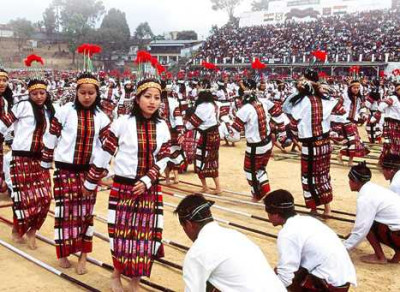History & Traditions
The Meaning and Origin of Chavang Kut
The term “Chavang Kut” comes from the Kuki dialect—“Chavang” means autumn, and “Kut” means festival—thus symbolizing the Festival of Autumn Harvest. Historically rooted in Manipur, Chavang Kut has spread widely across the northeastern states, especially in Assam, Mizoram, and Nagaland, where the Kuki population thrives. It has now evolved from a simple agrarian festival into a vibrant cultural celebration that preserves the Kuki identity and heritage.
Cultural and Religious Significance of Chavang Kut
Chavang Kut is not just a celebration of the harvest but also a time to thank the gods and nature for their blessings. It highlights the deep agricultural connection of the Kuki people and serves as a cultural bridge between the younger and older generations. The festival promotes community harmony, respect for traditions, and unity among different tribal groups.
Rituals and Celebrations at Chavang Kut
The Chavang Kut Festival begins with thanksgiving prayers and rituals performed by village elders to honor the harvest gods. The celebrations that follow are marked by colorful traditional dances, folk songs, and community feasts.
Key highlights include:
-
Traditional Attire: Men and women wear beautifully embroidered Kuki costumes adorned with ornaments.
-
Cultural Performances: Folk dances like Cheraw (Bamboo Dance) and musical performances reflect the rhythm of tribal life.
-
Harvest Feast: Delicious dishes prepared from freshly harvested crops, local meat, and rice beer are shared among families and guests.
-
Sports and Competitions: Traditional games, beauty contests, and talent shows add fun and youth participation.
-
Thanksgiving Ceremony: Prayers are offered to deities for health, happiness, and prosperity in the coming year.
Where is Chavang Kut Celebrated?
While Manipur remains the traditional center of celebration, Chavang Kut has gained immense popularity in Assam, particularly in regions with strong Kuki-Chin communities:
-
Dima Hasao (Haflong) – Major Kuki population centers host vibrant cultural shows.
-
Karbi Anglong – Celebrated in both rural and semi-urban Kuki areas.
-
Cachar & Hailakandi – Observed with community gatherings and youth programs.
-
Urban Centers: Cities like Guwahati and Silchar now host organized celebrations by Kuki student unions and cultural bodies.
Social and Cultural Importance of Chavang Kut
Beyond the rituals, Chavang Kut stands as a symbol of ethnic identity and cultural pride for the Kuki-Chin-Mizo people. It strengthens bonds within the community and fosters inter-tribal harmony. The festival also helps preserve traditional music, cuisine, folklore, and craftsmanship that define the Kuki cultural fabric.
In modern times, Chavang Kut has become an inclusive celebration that attracts visitors, cultural enthusiasts, and researchers from across India. Supported by state cultural departments, it has also gained attention for promoting eco-friendly practices and tribal tourism in Northeast India.
Conclusion
The Chavang Kut Festival beautifully captures the spirit of gratitude, unity, and joy among the Kuki-Chin-Mizo tribes. Its rituals of thanksgiving, rhythmic dances, and community feasts reflect the deep connection between humans and nature. As one of Assam and Manipur’s most colorful harvest festivals, Chavang Kut continues to thrive as a living expression of the region’s cultural diversity and harmony.
Chavang Kut Festival Quick Info Table
| Festival Name | Chavang Kut Festival |
|---|---|
| Celebrated By | Kuki-Chin-Mizo Tribes |
| Type of Festival | Autumn Harvest Festival |
| Duration | 1 Day (November 1st) |
| Main Locations | Manipur, Assam (Dima Hasao, Haflong, Karbi Anglong, Cachar, Hailakandi, Guwahati and Silchar) |
| Key Rituals | Thanksgiving prayers, folk dances, feasts, traditional music |
| Cultural Activities | Cheraw dance, traditional games, fashion shows, singing competitions |
| Significance | Gratitude for harvest, community unity, cultural pride |
| Religious Influence | Animism blended with Christianity and tribal traditions |
| Tourism Importance | Promotes tribal heritage and eco-cultural tourism in Northeast India |
Chavang Kut festival FAQs
-
What is Chavang Kut Festival?Chavang Kut is an autumn harvest festival celebrated by the Kuki-Chin-Mizo tribes to thank the gods for a successful harvest.
-
When is Chavang Kut celebrated?It is celebrated annually on November 1st, marking the end of the harvest season.
-
What does Chavang Kut mean?“Chavang” means autumn, and “Kut” means festival, together symbolizing the Festival of Autumn Harvest.
-
Where is Chavang Kut celebrated in Assam?The festival is celebrated in Dima Hasao, Haflong, Karbi Anglong, Cachar, Hailakandi, Guwahati and Silchar by the Kuki community.
-
Which communities celebrate Chavang Kut?The Kuki-Chin-Mizo tribes of Northeast India are the primary communities that celebrate the festival.
-
What are the main rituals of Chavang Kut?Prayers, cultural dances, traditional songs, and harvest feasts are the main rituals of the festival.
-
What is the significance of Chavang Kut?The festival signifies gratitude, community unity, and the celebration of nature’s bounty.
-
What foods are prepared during Chavang Kut?Traditional dishes made from newly harvested rice, local meat, and rice beer are commonly enjoyed.
-
How is Chavang Kut celebrated in urban areas?In cities like Guwahati and Silchar, it is celebrated with cultural programs, fashion shows, and music events.
-
Can tourists attend the Chavang Kut Festival?Yes, the festival welcomes visitors and offers an authentic experience of tribal culture and hospitality.
